
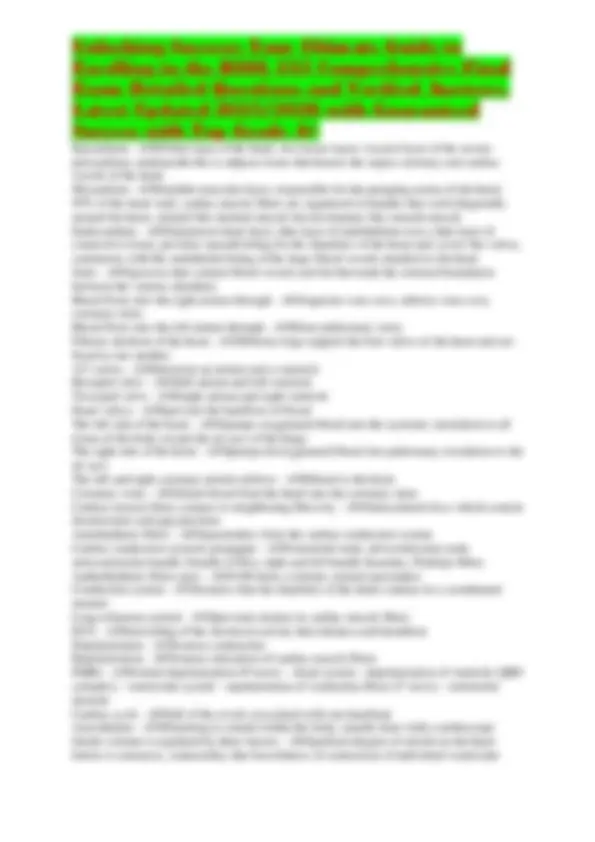
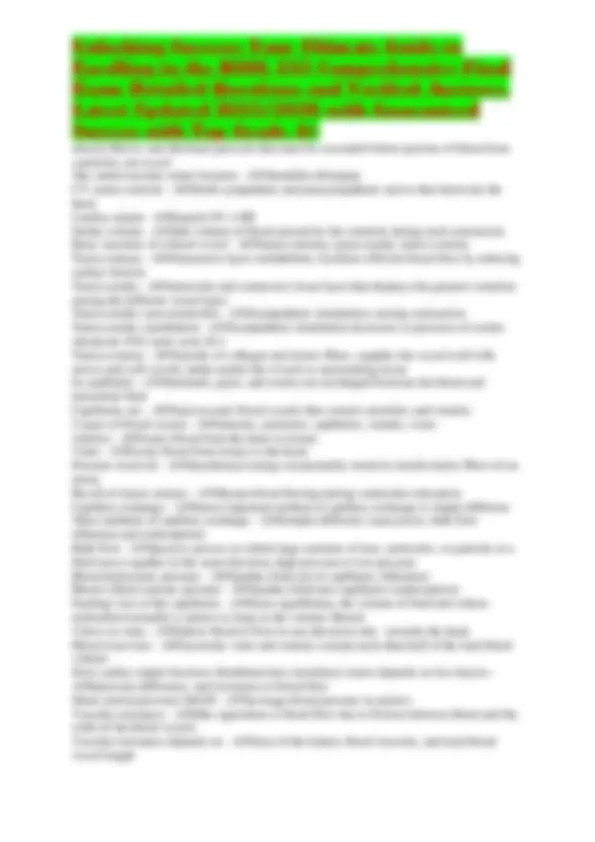
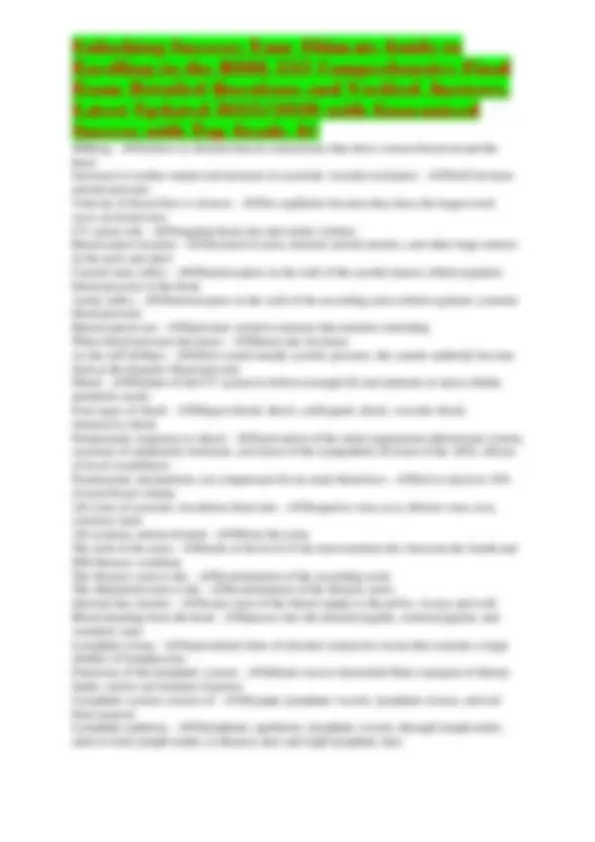
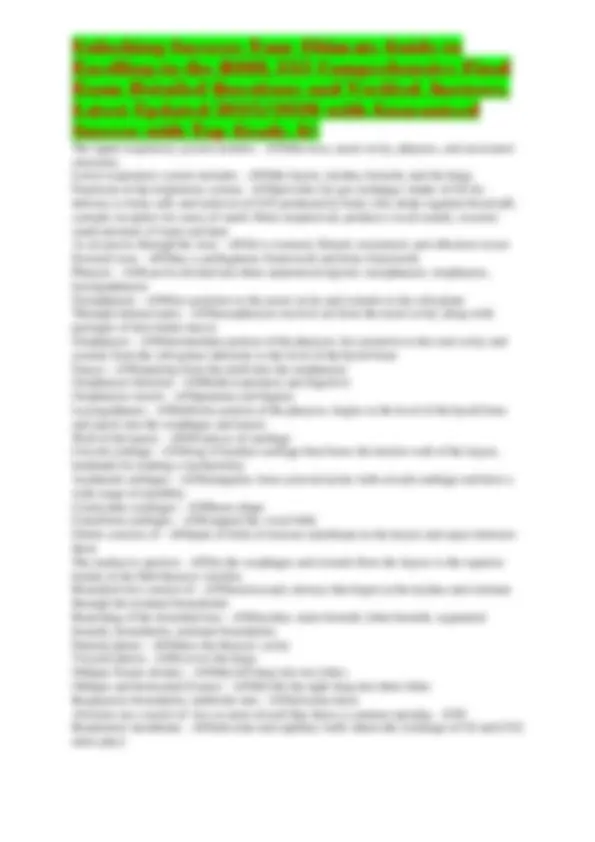
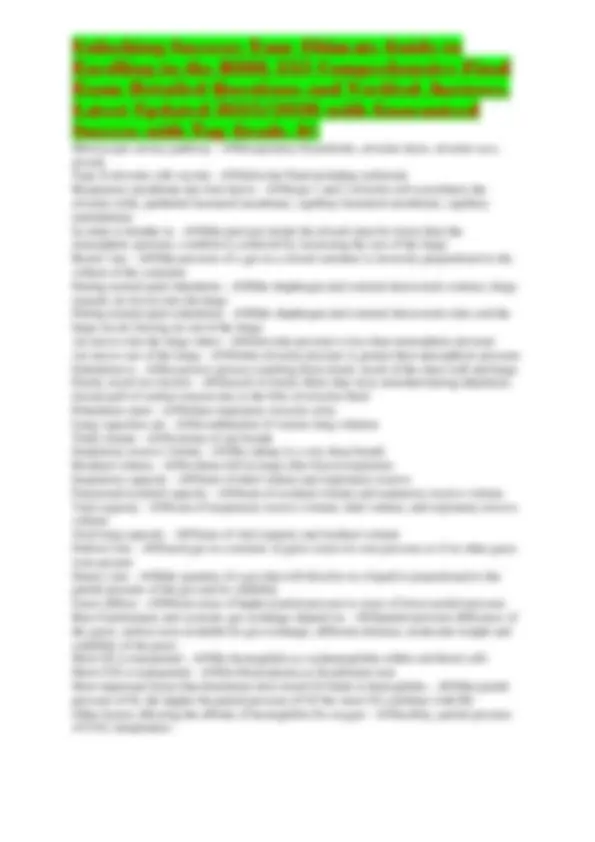
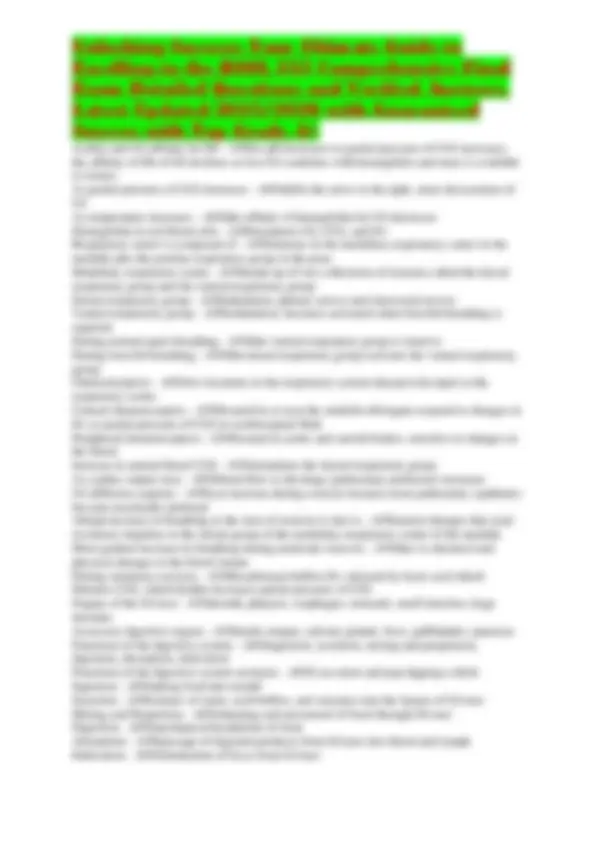
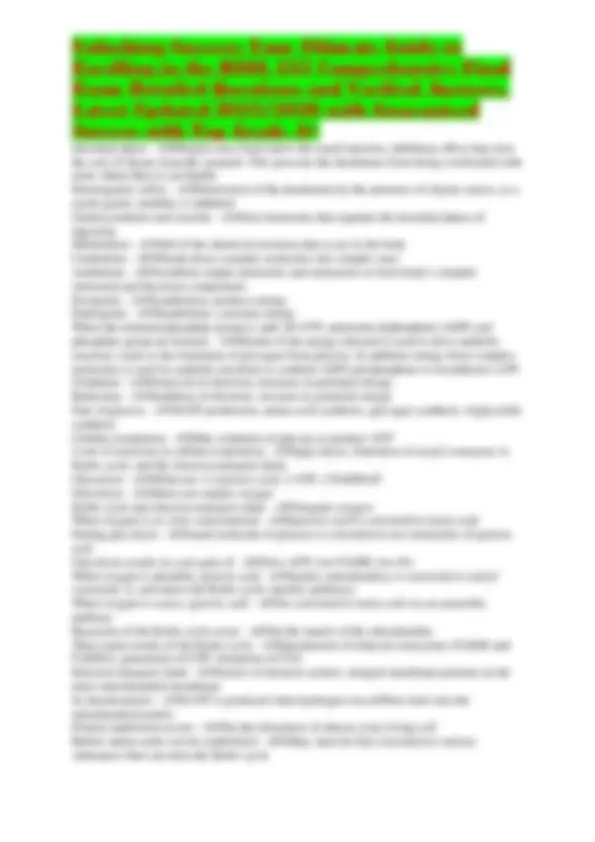
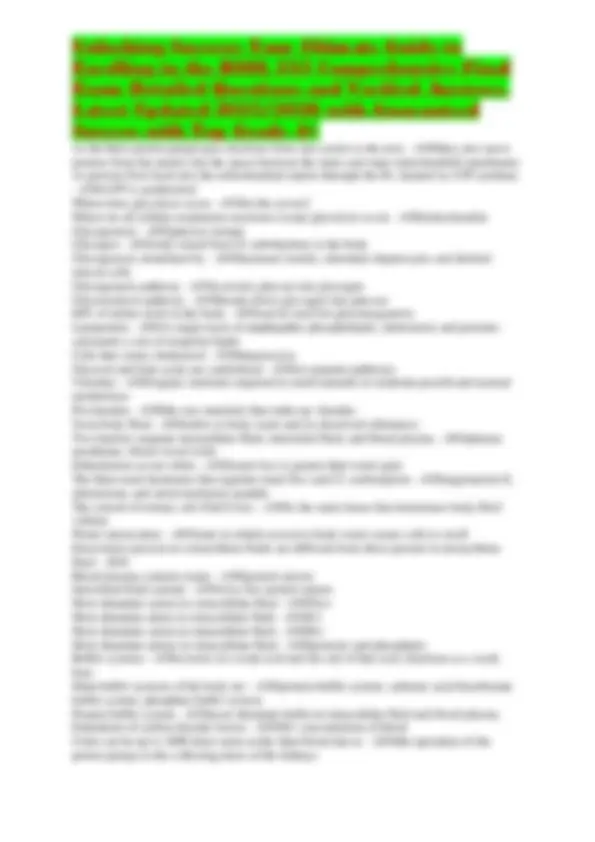
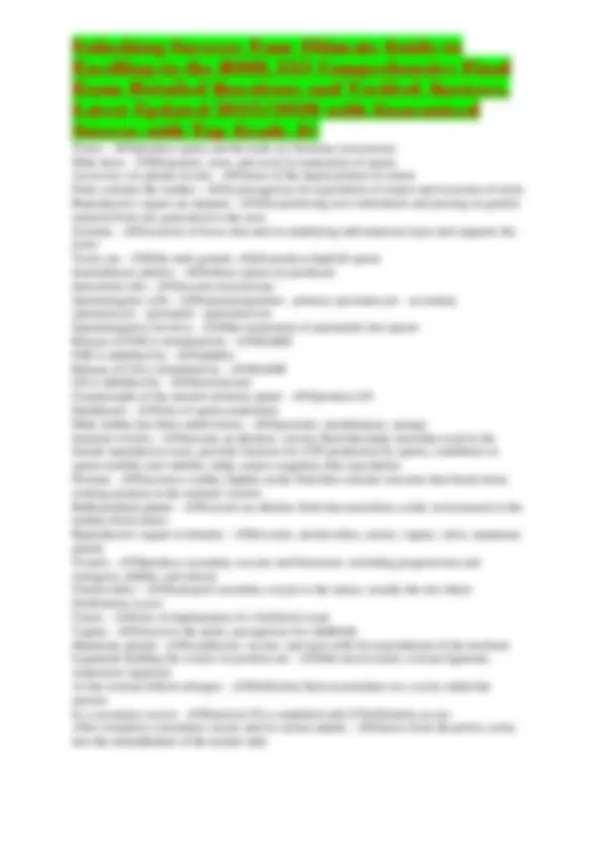
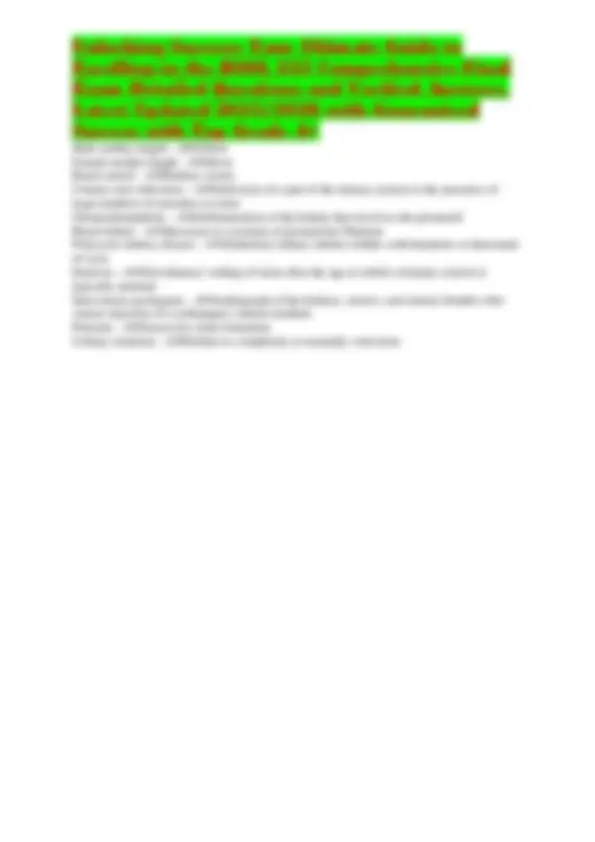


Study with the several resources on Docsity

Earn points by helping other students or get them with a premium plan


Prepare for your exams
Study with the several resources on Docsity

Earn points to download
Earn points by helping other students or get them with a premium plan
Community
Ask the community for help and clear up your study doubts
Discover the best universities in your country according to Docsity users
Free resources
Download our free guides on studying techniques, anxiety management strategies, and thesis advice from Docsity tutors
Unlocking Success: Your Ultimate Guide to Excelling in the BIOL 235 Comprehensive Final Exam Detailed Questions and Verified Answers. Latest Updated 2025/2026 with Guaranteed Success with Top Grade A+
Typology: Exams
1 / 18

This page cannot be seen from the preview
Don't miss anything!











Erythrocytes contain the enzyme - ANScarbonic anhydrase carbonic anhydrase catalyzes - ANSthe conversion of metabolically produced C)2 and water into carbonic acid fixed phagocytic macrophages - ANSremove most old erythrocytes from circulation Location of fixed phagocytic macrophages - ANSnarrow capillaries of the spleen Undifferentiated cells called pluripotent stem cells reside - ANSin the bone marrow pluripotent stem cells - ANScontinuously divide and develop myeloid stem cells and lymphoid stem cells to give rise to each of the types of blood cells emigration or diapedesis - ANSThe process of leukocytes squeezing through the capillary endothelium to exit the vasculature agglutinins - ANSgenetically-determined glycoprotein and glycolipid antigens found on the surface of an erythrocyte ESV - ANSvolume of blood in the ventricle after ejection has been completed Increase in ESV when - ANSstroke volume is decreased Three cations with important effect on heart function - ANSK+, Ca2+, and Na+ Increased blood levels of NA+ - ANSblocks Ca2+ inflow and decreases force of contraction Excess in K+ - ANSblocks generation of action potentials pharynx - ANSserves as a sound resonating chamber, contains tonsils, directs air flow inferiorly larynx - ANSpasses air form pharynx into windpipe, site of sound production paranasal sinuses - ANSresonates sound, not part of the pharynx fauces - ANSopening from oral cavity into pharynx tertiary bronchus - ANScarries air to a segment of a lung terminal bronchiole - ANScarries air directly into a respiratory bronchiole pleural membranes - ANSsurround the lungs surfactant - ANSreduces surface tension at sites of gas exchange alveoli - ANSactual sites of gas exchange eupnea - ANSnormal, quiet breathing costal breathing - ANSshallow breathing using just the external intercostal muscles compliance - ANSamount of effort required to expand the lungs and chest wall inspiratory capacity - ANStidal volume + inspiratory reserve volume, usually about 3600 mL in males vital capacity - ANStidal volume + inspiratory reserve volume + expiratory reserve volume; usually about 4800 mL in males functional residual capacity - ANSresidual volume + expiratory reserve volume; usually about 2400 mL in males Henry's law - ANSstates that the amount of gas that will dissolve in a liquid is proportional to the partial pressure of that gas and its solubility Bohr effect - ANSwhen pH decreases, O2 saturation of hemoglobin decreases Dalton's law - ANSeach gas in a mixture of gases exerts its own partial pressure medulla oblongata - ANSsets basic rhythm of breathing pons - ANSincludes the pontine respiratory group Blood is - ANSa connective tissue that consists of blood plasma (liquid) plus formed elements (red blood cells, white blood cells, and platelets) Whole blood - ANSblood plasma and formed elements
Blood plasma - ANSproteins, water, other solutes Blood plasma proteins - ANSalbumins (54%), globulins (36%), fibrinogens (7%) Formed elements - ANSred blood cells, white blood cells, platelets Blood cell production - ANShemopoesis, mainly occurs in red bone marrow after birth Reticulocyte - ANSfrom proerythrocyte, ejects nucleus Average lifespan of an erythrocyte - ANS120 days Rate of RBC formation by red blood cells - ANSequals the rate of RBC destruction by macrophages Emigration or diapedesis is - ANSthe process by which phagocytic cells leave blood vessels WBCs use to destroy pathogens - ANSlysozyme, defensins, and certain anions Neutrophils - ANSare usually the first and most numerous responders to an infection Macrophages - ANSreact more slowly to an infection than neutrophils do Pluripotent stem cells are derived from - ANSmesenchyme Megakaryoblasts - ANSplatelet precursor cells, develop into megakaryocytes Platelet - ANSfragment of megakaryocyte that is enclosed by a piece of plasma membrane Platelet plug - ANScan stop blood loss completely if the hole in a blood vessel is small enough Hemostasis - ANSsequence of responses that stops bleeding, vascular spasm, platelet plug formation, blood clotting Blood clot - ANSgel that contains formed elements of the blood entangled in fibrin threads In blood clotting - ANScoagulation factors are activated in sequence, resulting in a cascade of reactions that includes positive feedback cycles Extrinsic pathway of blood clotting - ANSfewer steps, thromboplastic leaks into the blood from cells outside (extrinsic to) blood vessels and initiates the formation of prothrombinase Intrinsic pathway of blood clotting - ANSmore complex, occurs more slowly, activators are in direct contact with blood or contained within (intrinsic to) the blood. Outside tissue damage is not needed. clotting pathway - ANSProthrombinase - prothrombin - thrombin - soluble fibrinogen - insoluble fibrin - threads of clot Common pathway - ANSformation of prothrombinase marks the beginning of the____ In an incompatible blood transfusion - ANSantibodies in the recipient's plasma bind to the antigens on the donated RBCs which causes agglutination (clumping) Antibodies in your plasma don't react with - ANSantigens on your red blood cells HDN - ANSoccurs when maternal anti-Rh antibodies cross the placenta and cause hemolysis of fetal RBC ABO blood typing - ANSblood is mixed with anti-A and anti-B serum The heart is located in - ANSthe mediastinum Pericardium - ANStriple-layered sac that surrounds and protects the heart Pericardium two main parts - ANSfibrous pericardium and serous pericardium Fibrous pericardium - ANSsuperficial, tough, inelastic, bag that attaches to the diaphragm, prevents overstretching of the heart, anchors the heart in the mediastinum Serous pericardium - ANSparietal layer, visceral layer (epicardium) Visceral layer of the serous pericardium - ANSone of the layers of the heart wall
muscle fibers), and afterload (pressure that must be exceeded before ejection of blood from ventricles can occur) The cardiovascular center location - ANSmedulla oblongata CV center controls - ANSboth sympathetic and parasympathetic nerves that innervate the heart Cardiac output - ANSequals SV x HR Stroke volume - ANSthe volume of blood ejected by the ventricle during each contraction Basic structure of a blood vessel - ANStunica interna, tunica media, tunica externa Tunica interna - ANSinnermost layer endothelium, facilitate efficient blood flow by reducing surface friction Tunica media - ANSmuscular and connective tissue layer that displays the greatest variation among the different vessel types Tunica media vasoconstriction - ANSsympathetic stimulation causing contraction Tunica media vasodilation - ANSsympathetic stimulation decreases or presence of certain chemicals (NO, lactic acid, H+) Tunica externa - ANSmostly of collagen and elastic fibers, supplies the vessel wall with nerves and self-vessels, helps anchor the vessels to surrounding tissue In capillaries - ANSnutrients, gases, and wastes are exchanged between the blood and interstitial fluid Capillaries are - ANSmicroscopic blood vessels that connect arterioles and venules 5 types of blood vessels - ANSarteries, arterioles, capillaries, venules, veins Arteries - ANScarry blood from the heart to tissues Veins - ANScarry blood from tissues to the heart Pressure reservoir - ANSmechanical energy momentarily stored in stretch elastic fibers of an artery Recoil of elastic arteries - ANSkeeps blood flowing during ventricular relaxation Capillary exchange - ANSmost important method of capillary exchange is simple diffusion Three methods of capillary exchange - ANSsimple diffusion, transcytosis, bulk flow (filtration and reabsorption) Bulk flow - ANSpassive process in which large amounts of ions, molecules, or particles in a fluid move together in the same direction, high pressure to low pressure Blood hydrostatic pressure - ANSpushes fluid out of capillaries (filtration) Blood colloid osmotic pressure - ANSpushes fluid into capillaries (reabsorption) Starling's law of the capillaries - ANSnear equilibrium, the volume of fluid and solutes reabsorbed normally is almost as large as the volume filtered Valves in veins - ANSallow blood to flow in one direction only - towards the heart Blood reservoirs - ANSsystemic veins and venules contain more than half of the total blood volume How cardiac output becomes distributed into circulatory routes depends on two factors - ANSpressure difference, and resistance to blood flow Mean arterial pressure (MAP) - ANSaverage blood pressure in arteries Vascular resistance - ANSthe opposition to blood flow due to friction between blood and the walls of the blood vessels Vascular resistance depends on - ANSsize of the lumen, blood viscosity, and total blood vessel length
Milking - ANSreferes to skeletal muscle contractions that drive venous blood toward the heart Increases in cardiac output and increases in systemic vascular resistance - ANSwill increase arterial pressure Velocity of blood flow is slowest - ANSin capillaries because they have the largest total cross-sectional area CV center role - ANSregulate heart rate and stroke volume Baroreceptor location - ANSlocated in aorta, internal carotid arteries, and other large arteries in the neck and chest Carotid sinus reflex - ANSbaroreceptors in the wall of the carotid sinuses which regulates blood pressure in the brain Aortic reflex - ANSbaroreceptors in the wall of the ascending aorta which regulates systemic blood pressure Baroreceptors are - ANSpressure sensitive neurons that monitor stretching When blood pressure decreases - ANSheart rate increases As the cuff deflates - ANSfirst sound usually systolic pressure, the sounds suddenly become faint at the diastolic blood pressure Shock - ANSfailure of the CV system to deliver enough O2 and nutrients to meet cellular metabolic needs Four types of shock - ANShypovolemic shock, cardiogenic shock, vascular shock, obstructive shock Homeostatic responses to shock - ANSactivation of the renin-angiotensin-aldosterone system, secretion of antidiuretic hormone, activation of the sympathetic division of the ANS, release of local vasodilators Homeostatic mechanisms can compensate for an acute blood loss - ANSof as much as 10% of total blood volume All veins of systemic circulation drain into - ANSsuperior vena cava, inferior vena cava, coronary sinus All systemic arteries branch - ANSfrom the aorta The arch of the aorta - ANSends at the level of the intervertebral disc between the fourth and fifth thoracic vertebrae The thoracic aorta is the - ANScontinuation of the ascending aorta The abdominal aorta is the - ANScontinuation of the thoracic aorta Internal iliac arteries - ANScarry most of the blood supply to the pelvic viscera and wall Blood draining from the head - ANSpasses into the internal jugular, external jugular, and vertebral veins Lymphatic tissue - ANSspecialized form of reticular connective tissue that contains a large number of lymphocytes Functions of the lymphatic system - ANSdrains excess interstitial fluid, transport of dietary lipids, carries out immune response Lymphatic system consists of - ANSlymph, lymphatic vessels, lymphatic tissues, and red bone marrow Lymphatic pathway - ANSlymphatic capillaries, lymphatic vessels, through lymph nodes, unite to form lymph trunks, to thoracic duct and right lymphatic duct
Cytokine - ANSsmall protein hormones that stimulate or inhibit many normal cell functions, such as cell growth and differentiation Cell mediated immunity begins with - ANSactivation of a small number of T cells by a specific antigen, once a T cells has been activated, it undergoes clonal selection Once a helper T cell is activated - ANSit forms a clone of active helper T cells and memory helper T cells Once a cytotoxic T Cell is activated - ANSit forms a clone of active cytotoxic T cells and memory cytotoxic T cells Cytotoxic T cells release: granzymes that trigger apoptosis and perforin that triggers cytolysis of infected target cells - ANS Plasma cells - ANSsecrete antibodies Complement system - ANSdefensive system made up of over 30 proteins produced by the liver and found circulating in blood plasma whiting tissues throughout the body. Complement system destroys microbes by - ANScausing phagocytosis, cytolysis, and inflammation Immunological memory is the basis - ANSfor successful immunization by vaccination First signal in activation of a T cell - ANSantigen recognition by a TCR with CD4 or CD proteins Second signal - ANST cell will only become activated if it binds to a the foreign antigen and at the same time receives a second signal, costimulation Interleukin- 2 - ANScytokine that acts as a costimulatory Anergy - ANSprolonged state of inactivity caused by binding of the antigen to a receptor, without costimulation Once costimulation occurs - ANSan activated T cells undergoes clonal selection Most T cells that display CD4: develop into helper T cells, also known as CD4 T cells - ANS Once activated helper T cells: formation of a clone of helper T cells that consists of active helper T cells and memory helper T cells - ANS Active helper T cells - ANSsecrete cytokines T cells that display CD8 - ANSdevelop into cytotoxic T cells (CD8 T cells) Cytotoxic T cells recognize foreign antigens combined with - ANSMHC class I Helper T cells are activated by antigens associated with - ANSMHC class II Maximal activation of cytotoxic T cells - ANSrequired presentation of antigen associated with both MHC-I and MHC-II molecules Effector cell of a B cell clone - ANSplasma cells, secrete specific antibodies Immunoglobulins (Tgs) - ANSantibodies belong to a group of glycoproteins called globulins An antibody combines only - ANSwith the epitope on the antigen that triggered its production H chains - ANStwo chains in antibody L chains - ANStwo identical chains in antibodies Disulfide bond - ANSholds each light chain to a heavy chain Variable (V) regions - ANSconstitute the antigen-binding site Constant C region - ANSnearly the same in all antibodies of the same class Main cytokines - ANSinterleukin 1, 2, 3, 5, 6, tumor necrosis factor, interferons, macrophage migration inhibiting factor
The upper respiratory system includes - ANSthe nose, nasal cavity, pharynx, and associated structures Lower respiratory system includes - ANSthe larynx, trachea, bronchi, and the lungs Functions of the respiratory system - ANSprovides for gas exchange: intake of O2 for delivery to body cells and removal of CO2 produced by body cells, helps regulate blood pH, contains receptors for sense of smell, filters inspired air, produces vocal sounds, excretes small amounts of water and heat As air passes through the nose - ANSit is warmed, filtered, moistened, and olfaction occurs External nose - ANShas a cartilaginous framework and bony framework Pharynx - ANScan be divided into three anatomical regions: nasopharynx, oropharynx, laryngopharynx Nasopharynx - ANSlies posterior to the nasal cavity and extends to the soft palate Through internal nares - ANSnasopharynx receives air from the nasal cavity along with packages of dust-laden mucus Oropharynx - ANSintermediate portion of the pharynx, lies posterior to the oral cavity and extends from the soft palate inferiorly to the level of the hyoid bone Fauces - ANSopening from the moth into the oropharynx Oropharynx function - ANSboth respiratory and digestive Oropharynx tonsils - ANSpalatine and lingual Laryngopharnx - ANSinferior portion of the pharynx, begins at the level of the hyoid bone and opens into the esophagus and larynx Wall of the larynx - ANS9 pieces of cartilage Cricoid cartilage - ANSring of hyaline cartilage that forms the interior wall of the larynx, landmark for making a tracheotomy Arythnoid cartilages - ANStriangular, form synovial joints with cricoid cartilage and have a wide range of motiblity Corniculate cartilages - ANShorn-shape Cuneiform cartilages - ANSsupport the vocal folds Glottis consists of - ANSpair of folds of mucous membrane in the larynx and space between them The trachea is anterior - ANSto the esophagus and extends from the larynx to the superior border of the fifth thoracic vertebra Bronchial tree consists of - ANSmacroscopic airways that begin at the trachea and continue through the terminal bronchioles Branching of the bronchial tree - ANStrachea, main bronchi, lobar bronchi, segmental bronchi, bronchioles, terminal bronchioles Parietal pleura - ANSlines the thoracic cavity Visceral pleura - ANScovers the lungs Oblique fissure divides - ANSthe left lung into two lobes Oblique and horizontal fissures - ANSdivide the right lung into three lobes Respiratory bronchioles subdivide into - ANSalveolar ducts Alveolar sacs consist of: two or more alveoli that share a common opening - ANS Respiratory membrane - ANSalveolar and capillary walls where the exchange of O2 and CO takes place
Acidity and O2 affinity for Hb - ANSas pH decreases or partial pressure of CO2 increases, the affinity of Hb of O2 declines so less O2 combines with hemoglobin and more is available to tissues As partial pressure of CO2 increases - ANSshifts the curve to the right, more dissociation of O As temperature increases - ANSthe affinity of hemoglobin for O2 decreases Hemoglobin in red blood cells - ANStransports O2, CO2, and H+ Respiratory center is composed of - ANSneurons in the medullary respiratory center in the medulla plus the pontine respiratory group in the pons Medullary respiratory center - ANSmade up of two collections of neurons called the dorsal respiratory group and the ventral respiratory group Dorsal respiratory group - ANSinhalation, phrenic nerves and intercostal nerves Ventral respiratory group - ANSexhalation, becomes activated when forceful breathing is required During normal quiet breathing - ANSthe ventral respiratory group is inactive During forceful breathing - ANSthe dorsal respiratory group activates the ventral respiratory group Chemoreceptors - ANStwo locations in the respiratory system that provide input to the respiratory center Central chemoreceptors - ANSlocated in or near the medulla oblongata respond to changes in H+ or partial pressure of CO2 in cerebrospinal fluid Peripheral chemoreceptors - ANSlocated in aortic and carotid bodies, sensitive to changes in the blood Increase in arterial blood CO2 - ANSstimulates the dorsal respiratory group As cardiac output rises - ANSblood flow to the lungs (pulmonary perfusion) increases O2 diffusion capacity - ANScan increase during exercise because more pulmonary capillaries become maximally perfused Abrupt increase in breathing at the start of exercise is due to - ANSneural changes that send excitatory impulses to the dorsal group of the medullary respiratory center of the medulla More gradual increase in breathing during moderate exercise - ANSdue to chemical and physical changes in the blood stream During strenuous exercise - ANSbicarbonate buffers H+ released by lactic acid which liberates CO2, which further increases partial pressure of CO Organs of the GI tract - ANSmouth, pharynx, esophagus, stomach, small intestine, large intestine Accessory digestive organs - ANSteeth, tongue, salivary glands, liver, gallbladder, pancreas Functions of the digestive system - ANSingestion, secretion, mixing and propulsion, digestion, absorption, defecation Functions of the digestive system acronym - ANSI see mom and pop digging a ditch Ingestion - ANStaking food into mouth Secretion - ANSrelease of water, acid buffers, and enzymes into the lumen of GI tract Mixing and Propulsion - ANSchurning and movement of food through GI tract Digestion - ANSmechanical breakdown of food Absorption - ANSpassage of digested products from GI tract into blood and lymph Defecation - ANSelimination of feces from GI tract
Four layers of the GI tract - ANSmucosa, submucosa, muscularis and serosa Mucosa - ANSthree layers 1) epithelium 2) lamina propria 3) thin layer of smooth muscle Lamina propria - ANSareolar connective tissue containing many blood and lymphatic vessels which are the routes by which nutrients absorbed into the GI tract reach the other tissues of the body Muscularis - ANSlayer of the GI tract, contains skeletal muscle The gastrointestinal tract is regulated by - ANSintrinsic set of nerves known as the enteric nervous system and by an extrinsic set of nerves that are part of the autonomic nervous system Neurons of the enteric nervous system are arranged in two plexus - ANSmyenteric plexus and submucosal plexus Myenteric plexus location - ANSlocated between layers of the muscularis Submucosal plexus - ANSfound within the submucosa Plexus of ENS contain - ANSmotor neurons, interneurons, sensory neurons Although the neurons of the ENS can function independently, - ANSthey are subject to regulation by neurons of the autonomic nervous system. Vagus (X) nerve - ANSsupply the parasympathetic fibers to most of the GI tract Parasympathetic nerves that supply the GI tract form - ANSneural connections with the ENS Parasympathetic preganglionic neurons of the vagus or pelvic splanchinic nerves synapse with - ANSparasympathetic postganglionic neurons located in the myenteric and submucosal plexuses Sympathetic nerves that supply the GI tract - ANSarise from the thoracic and upper lumbar regions of the spinal cord Peritoneum - ANSlargest serous membrane in the body Mouth is formed by - ANScheeks, hard and soft palates, and tongue Salivary amylase - ANSenzyme that starts the breakdown of starch in the mouth Saliva - ANSlubricates and dissolves foods and begins the chemical breakdown of carbohydrates and lipids Teeth are anchored in sockets of the alveolar processes of the mandible and maxillae - ANS Esophagus - ANSsecretes mucus and transports food to the stomach Upper esophageal sphincter - ANSskeletal muscle, regulates movement of food into the esophagus Lower esophageal sphincter - ANSsmooth muscle, regulates movement of food out of the esophagus into the stomach Adventitia - ANSsuperficial layer of the esophagus Deglutition - ANSact of swallowing Deglutition stages - ANSvoluntary, pharyngeal stage, esophageal stage Voluntary stage - ANSbolus is passed into the oropharynx Pharyngeal stage - ANSinvoluntary, bolus through the pharynx into the esophagus, bolus stimulates receptors in the oropharynx that send impulses to the deglutition center in the medulla oblongata Four regions of the stomach are - ANSthe cardia, fundus, body, pyloric part Functions of the stomach - ANSmixes saliva, food, and gastric juice to form chyme, serves as reservoir for food before release into small intestine, secretes gastric juice, secretes gastrin into blood
Intestinal phase - ANSbegins once food enters the small intestine, inhibitory effect that slow the exit of chyme from the stomach. This prevents the duodenum from being overloaded with more chime than it can handle Enterogastric reflex - ANSdistension of the duodenum by the presence of chyme causes, as a result gastric mobility is inhibited Cholecystokinin and secretin - ANStwo hormones that regulate the intestinal phase of digestion Metabolism - ANSall of the chemical reactions that occur in the body Catabolism - ANSbreak down complex molecules into simpler ones Anabolism - ANScombine simple molecules and monomers to form body's complex structural and functions components Exergonic - ANScatabolism, produce energy Endergonic - ANSanabolism, consume energy When the terminal phosphate group is split off ATP, adenosine diphosphate (ADP) and phosphate group are formed. - ANSSome of the energy released is used to drive anabolic reaction s such as the formation of glycogen from glucose. In addition energy from complex molecules is used in catabolic reactions to combine ADP and phosphate to resynthesize ATP. Oxidation - ANSremoval of electrons, decrease in potential energy Reduction - ANSaddition of electrons, increase in potential energy Fate of glucose - ANSATP production, amino acid synthesis, glycogen synthesis, triglyceride synthesis Cellular respiration - ANSthe oxidation of glucose to product ATP 4 sets of reactions in cellular respiration - ANSglycolysis, formation of acetyl coenzyme A, Krebs cycle, and the electron transport chain Glycolysis - ANSGlucose = 2 pyruvic acid, 2 ATP, 2 HADH+H Glycolysis - ANSdoes not require oxygen Krebs cycle and electron transport chain - ANSrequire oxygen When oxygen is at a low concentration - ANSpyruvic acid is converted to lactic acid During glycolysis - ANSeach molecule of glucose is converted to two molecules of pyruvic acid Glycolysis results in a net gain of - ANStwo ATP, two NADH, two H+ When oxygen is plentiful, pyruvic acid - ANSenters mitochondria, is converted to acetyl coenzyme A, and enters the Krebs cycle (aerobic pathway) When oxygen is scarce, pyruvic acid - ANSis converted to lactic acid via an anaerobic pathway Reactions of the Krebs cycle occur - ANSin the matrix of the mitochondria Three main results of the Krebs cycle - ANSproduction of reduced coenzymes (NADH and FADH2), generation of GTP, formation of CO Electron transport chain - ANSseries of electron carriers, integral membrane proteins in the inner mitochondrial membrane In chemiosmosis - ANSATP is produced when hydrogen ions diffuse back into the mitochondrial matrix Protein anabolism occurs - ANSin the ribosomes of almost every living cell Before amino acids can be catabolized - ANSthey must be first converted to various substances that can enter the Krebs cycle
As the three proton pumps pass electrons form one carrier to the next - ANSthey also move protons from the matrix into the space between the inner and outer mitochondrial membranes As protons flow back into the mitochondrial matrix through the H+ channel in ATP synthase
Peristaltic contractions of the muscularis and ciliary action of the mucosa of the uterine tube help move the oocyte or fertilized ovum towards the uterus - ANS Three layers of the uterus (superficial to deep) - ANSperimetrium, the myometrium, endometrium Straight arterioles supply - ANSthe materials needed for regeneration of the stratum functionalis Vulva refers to - ANSthe external genitals of the female Perineum is a diamond shaped area that includes - ANSthe urogenital triangle and the anal triangle Estrogens - ANSpromote development and maintenance of female reproductive structures, increase protein anabolis, lower blood cholesterol, inhibit release of GnHR, FSH, LH Progesterone - ANSworks with estrogens to prepare entometrium for implantation, prepares mammary glands to secrete milk, inhibits release of GnHR and LH Relaxin - ANSinhibits contractions of uterine smooth muscle, during labour increases flexitility of bupic symphysis and dilates uterine cervix Inhibin - ANSinhibits release of FSH and LH At midcycle - ANSa surge in LH triggers ovulation Hormones from the anterior pituitary gland - ANSregulate ovarian function Hormones form the ovaries regulate - ANSthe changes in the endometrial lining of the uterus During fertilization - ANSgenetic material from a sperm cell and a secondary oocyte merge to form a single diploid nucleus Path of sperm - ANScorona radiate, zona pellucida, plasma memebrane of secondary oocyte, cytoplasm of secondary oocyte Cleavage refers to - ANSthe early rapid mitotic divisions of a zygote Implantation - ANSthe attachment of a blastocyst to the endometrium occurs about 6 days after fertilization Decidua - ANSmodified portion of the endometrium that develops after implantation Decdidua basalis - ANSbecomes the maternal part of the placenta About 8 days after fertilization the trophoblast: develops into a synctiotophoblast and a cytotrophoblast - ANS Aber 8 days after fertilization the embryoblast - ANSdevelops into a hypoblast and epiblast Yolk sac - ANSsupplies nutrients to the embryo, source of blood cells, contains the first cells that will eventually migrate into developing gonads Chorion - ANSeventually becomes the principal embryonic part of the placenta Gastrulation - ANSinvolves the rearrangement and migration of cells from the epiblast Notochordal process develops from - ANSthe primitive node and later becomes the notochord Neuralation - ANSprocess by which neural plate, neural folds, neural tube form Blood vessels in chorionic villi - ANSconnect to the embryonic heart via the umbilical arteries and the umbilical vein, which will eventually become the umbilical cord Intervillous spaces - ANSwhere fetal blood capillaries within the chorionic villi protect into the lacunae, maternal blood bathes the chorionic villi Placenta is formed by - ANSchorionic villi of the embryo and the decidua basalis of the endometrium of the mother
Functions of the kidneys - ANSregulation of blood ionic composition, regulation of blood pH, regulation of blood volume, regulation of blood pressure, maintenance of blood osmolarity, production of hormones, regulation of blood glucose level, excretion of wastes and foreign substances Osmolarity - ANSthe measure of the total number of dissolved particles per liter of solution Kidneys are surrounded by - ANSrenal capsule, adipose capsule, renal fascia Two main regions of the kidney - ANSsuperficial light red region called the renal cortex and the deep, dark red region called the renal medulla Path of urine drainage - ANScollecting duct, papillary duct, minor calyx, major calyx, renal pelvis, ureter, urinary bladder Renal arteries deliver - ANS20-25% of the resting cardiac output to the kidneys Nephron - ANSfunctional units of the kidneys Fluid passes through the renal tubule - ANSproximal convoluted tubule, nephron loop, distal convoluted tubule Macula densa - ANScolumnar tubule cells in the renal tubule Fluid passes through the renal tubule - ANSproximal convoluted tubule, nephron loop, distal convoluted tubule Not part of a nephron - ANScollecting duct and papillary duct Three basic functions performed by nephrons and collecting ducts - ANSglomerular filtration, tubular reabsorption, and tubular secretion Glomerular filtration - ANSfirst step of urine production, water and most solutes in blood plasma move across the wall of the glomerular capillaries, then into the renal tubule Tubular reabsorption - ANSas filtered fluid flows through the renal tubules and through the collecting ducts, tubule cells reabsorb about 99% of the filtered water and many useful solutes Tubular secretion - ANSrenal tubules secrete other materials, such as wastes, drugs, and excess ions into the fluid, removing a substance from the blood Glomerular filtration occurs - ANSin the renal corpuscle Tubular reabsorption and tubular secretion - ANSoccur all along the renal tubule and collecting duct Rate of urinary excretion of any solute - ANSis equal to its rate of glomerular filtration + rate of secretion - rate of reabsorption Glomerular blood hydrostatic pressure promotes - ANSfiltration Capsular hydrostatic pressure and blood colloid osmotic pressure - ANSoppose filtration Mechanism of renal autoregulation of GFR - ANSmyogenic mechanism, tubuloglomerular feedback Macula densa cells of the juxtaglomerular apparatus - ANSprovide negative feedback regulation of the glomerular filtration rate Two hormones contribute to regulation of GFR - ANSangiotensin II and atrial natriuretic peptide When ADH is level is low - ANSurine is dilute and has an osmolarity less than the osmolarity of blood Formation of concentrated urine depends on - ANShigh concentrations of solutes in the interstitial fluid in the renal medulla Micturition - ANSurine is stored in the urinary bladder before being expelled by ________